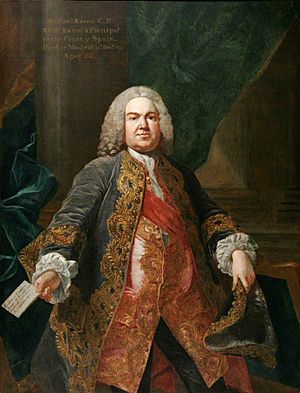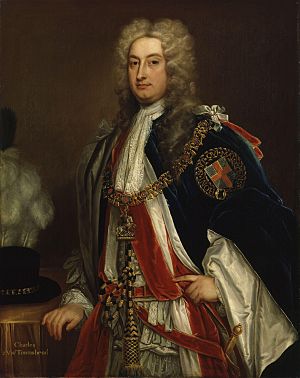Benjamin Keene facts for kids
Quick facts for kids
Sir
Benjamin Keene
|
|
|---|---|

Sir Benjamin Keene
|
|
| British Ambassador to Spain | |
| In office 1749–1757 |
|
| Monarch | George II |
| Preceded by | Vacant War of Jenkins' Ear |
| Succeeded by | Earl of Bristol |
| Ambassador to Portugal | |
| In office 1745–1749 |
|
| Preceded by | Charles Crompton |
| Succeeded by | Abraham Castres |
| MP for West Looe | |
| In office 1741–1747 |
|
| MP for Maldon | |
| In office January 1740 – April 1741 |
|
| British Ambassador to Spain | |
| In office 1729–1739 |
|
| Preceded by | Anglo-Spanish War |
| Succeeded by | War of Jenkins' Ear |
| Personal details | |
| Born | ca 1697 King's Lynn, Norfolk |
| Died | 15 December 1757 (aged 72) Madrid, Spain |
| Resting place | St Nicholas's Chapel, Kings Lynn, Norfolk |
| Nationality | English |
| Political party | Whigs |
| Parents | Charles Keene (1674–?) Susan Rolfe (? – 1753) |
| Alma mater | Pembroke College, Cambridge Leiden University |
| Occupation | Diplomat |
| Committees | Board of Trade 1741–1744 Paymaster of Pensions 1745–1746 |
Sir Benjamin Keene (born around 1697, died 1757) was a very important British diplomat. He served as Britain's Ambassador to Spain twice. His first time was from 1729 to 1739. He then returned from 1748 until he passed away in Madrid in December 1757. Many historians believe he was the most important British person working with Spain in the 1700s.
Keene first became the Consul General for Spain in 1724. Five years later, he became Ambassador. He helped create the 1729 Treaty of Seville. This treaty ended the Anglo-Spanish War that lasted from 1727 to 1729. Later, he worked on the 1739 Convention of Pardo. This agreement aimed to solve trade and border problems in the Caribbean. However, politicians in England did not approve it. This led to the War of Jenkins' Ear, which lasted from 1739 to 1748.
After returning to England, he became a Member of Parliament. He represented Maldon from 1740 to 1741. Then he represented West Looe until 1747. He joined the Board of Trade in 1741. In 1745, he became the Paymaster of Pensions. Keene found diplomacy more interesting than politics. So, in 1745, he moved to Lisbon to become the British Ambassador to Portugal.
After the Treaty of Aix-la-Chapelle in 1748, he went back to Madrid. His strong influence helped Spain stay neutral when the Seven Years' War started in 1756. He was so important that he stayed in his job until he died in December 1757. This was true even though he asked to retire many times due to poor health. His replacement did not have the same influence. Still, Spain did not join the war against Britain until 1762. This was a big reason for Britain's victory.
Contents
Sir Benjamin Keene's Early Life
Benjamin Keene was born around 1697 in King's Lynn, Norfolk. He was the oldest son of Charles Keene (born 1675) and Susan Rolfe (died 1753). His younger brother, Edmund (1714–1781), became the Bishop of Ely. He also became the Master of Peterhouse, Cambridge.
Both Benjamin's father and his uncle, also named Benjamin, served as Mayor of King's Lynn. His grandfather, Edmund Rolfe (1640–1726), was also Mayor. Rolfe was also an election helper for Sir Robert Walpole. Walpole was the British Prime Minister from 1721 to 1742. This family connection helped both Benjamin and his younger brother in their careers.
Keene never married. He left all his property to his brother Edmund. His nephew, Benjamin (1753–1837), became a Member of Parliament for Cambridge. He served from 1774 to 1786.
Keene's Diplomatic Career
Starting in Diplomacy (1718–1746)
Keene finished his studies at Pembroke College, Cambridge in 1718. He then studied law at Leiden University in the Netherlands. His family connections helped him get noticed by Viscount Townshend (1674–1738). Townshend was a powerful politician from Norfolk. He sent Keene to Madrid in 1723. Keene first worked for the South Sea Company. Then, in 1724, he became a Consul.

The South Sea Company was created to manage trade rights given to Britain. These rights came from the 1713 Treaty of Utrecht. They allowed Britain to trade in the closed markets of Spanish America. This included the Asiento de Negros, which allowed Britain to supply 5,000 enslaved people each year. It also included Navio de Permiso. This allowed limited direct sales in Porto Bello and Veracruz. The British government took over the company after it went bankrupt in the 1720 'South Sea Bubble'.
The asiento itself did not make much money. It was seen as a "commercial illusion." Between 1717 and 1733, only eight ships sailed from Britain to the Americas for this trade. The real benefit was in carrying smuggled goods. These goods avoided customs taxes. Spanish colonists wanted these goods, creating a large and profitable black market. There was also a lot of legal trade. British goods were brought through Cadiz. They were sold there or sent to the colonies. Spanish dyes and wool went the other way. A top merchant in London called this trade "the best flower in our garden."
Spain did not like being forced to open their colonial markets. This was partly because of the economic idea called mercantilism. This idea viewed trade as a limited resource. So, if Britain's share increased, it meant Spain's share decreased. Wars were often fought over trade issues. The Treaty of Utrecht also confirmed Britain's control of the Spanish ports of Gibraltar and Mahón. Spain wanted to get these back. This was a reason for the 1718 to 1720 War of the Quadruple Alliance. It also led to Spanish support for the Jacobite rising of 1719. Because of these tensions, the job of British Consul was very important. It needed someone with great skill and intelligence.
Keene's first big job was to negotiate the Treaty of Seville. This treaty ended the 1727 to 1729 Anglo-Spanish War. William Stanhope took credit for the treaty. He had returned from London for this purpose. Keene also negotiated the 1739 Convention of El Pardo. This was an effort to stop a war between the two countries. However, British merchants did not like the terms. The agreement was never officially approved.
When the War of Jenkins' Ear began in 1739, Keene returned to London. He was elected a Member of Parliament for Maldon. He was part of Henry Pelham's Whig government. He was re-elected for West Looe in the 1741 election. From 1741 to 1744, he was a member of the Board of Trade. Then, from 1745 to 1746, he was Paymaster of Pensions.
Later Diplomatic Work (1746–1757)
In July 1746, Philip V of Spain, who was born in France, died. His son, Ferdinand VI, became king. Ferdinand was more friendly towards Britain than his father. British foreign policy was managed by Pelham's younger brother, the Duke of Newcastle. He saw this as a chance to break the alliance between Spain and France. He also wanted to improve Britain's position in the War of the Austrian Succession.
Keene's personal letters show he did not enjoy being a Member of Parliament. He was happy to be appointed Ambassador to Portugal in 1745. Britain and Spain were still at war. So, Keene's job in Lisbon was to start talks with the new Spanish government. However, his discussions with the Marqués de Tabuérniga did not make much progress. This was mainly because Britain refused to consider returning Gibraltar.
After the Treaty of Aix-la-Chapelle ended the war in 1748, Keene went back to Madrid. He quickly built a good relationship with King Ferdinand and his ministers. They shared Newcastle's goal of moving Spain away from France and closer to Britain. In October 1750, Keene helped negotiate the Treaty of Madrid. This treaty solved trade problems between the two countries.
He also helped arrange the 1752 Treaty of Aranjuez. This treaty was between Spain, Austria, and Sardinia. In it, the three countries agreed to respect each other's borders in Italy. In 1754, he helped remove the pro-French minister, Marquis of Ensenada. Ricardo Wall, who used to be the Spanish ambassador in London, replaced him as Prime Minister. Keene's achievements were recognized. George II gave him the Order of the Bath. King Ferdinand presented this award to him in a special ceremony.
Even though Newcastle could not stop the 1756 Diplomatic Revolution (where Austria allied with France), Spain initially stayed out of the Seven Years' War. Keene's health was poor at this time. But his request to retire was denied. He was considered too valuable to British interests. He died in Madrid in 1757. George Hervey, 2nd Earl of Bristol replaced him. However, Bristol did not have the same influence. Charles III of Spain became king after Ferdinand in 1759. In 1762, Charles III entered the war on France's side.


